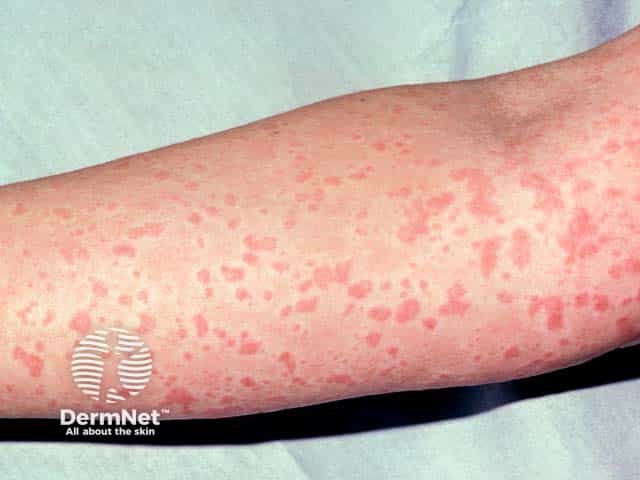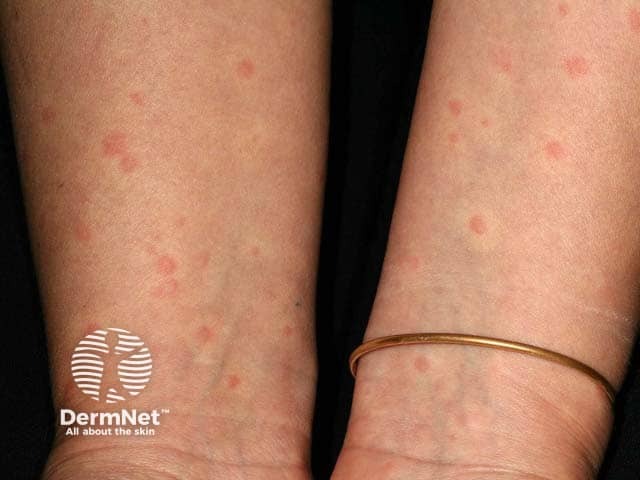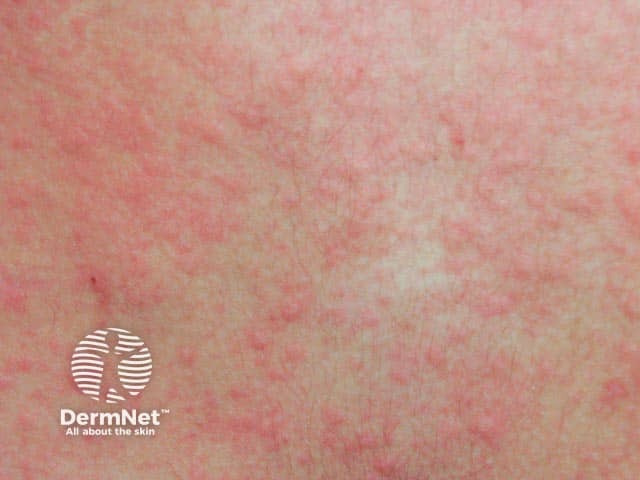Main menu
Common skin conditions

NEWS
Join DermNet PRO
Read more
Quick links
Cholinergic urticaria — extra information
Cholinergic urticaria
Author: Dr Lisa Murphy, Beaumont Hospital, Ireland. Copy edited by Gus Mitchell. July 2022
Introduction Demographics Causes Clinical features Complications Diagnosis Differential diagnoses Treatment Prevention Outcome
What is cholinergic urticaria?
Cholinergic urticaria is a common chronic inducible urticaria that is characterised by the presence of short-lived transient hives (itchy bumps) due to stimuli that induce sweating. It typically presents with small, raised 1–4 mm wheals which last for 15–30 minutes.
It is also sometimes referred to as cholinergic angioedema urticaria or heat bumps.
Who gets cholinergic urticaria?
The prevalence of this physical urticaria is higher in persons with chronic spontaneous urticaria. While the disorder occurs in both sexes, it occurs more frequently in males. It typically first develops in people aged 10–30 years.
What causes cholinergic urticaria?
Any stimulus that can cause excessive sweating can precipitate this inducible urticaria.
This includes:
- Exercise (most common trigger)
- High temperature exposure, eg, hot water baths
- Spicy food ingestion
- Emotional stress.
There are several theories regarding the pathogenesis including:
- Affected patients may have an increased number of muscarinic receptors on cutaneous mast cells in areas that demonstrate hives, therefore the cholinergic nervous system is the cause.
- The urticaria occurs as a result of a rise in core body temperature, associated with sweating.
- Other authorities postulate that rather than shifts in core body temperature, IgE-mediated allergy to a component of human sweat is the immediate trigger.
What are the clinical features of cholinergic urticaria?
Heat bumps typically present with:
- A number of small (1–4 mm) punctate wheals, often surrounded by a larger erythematous flare
- Wheals are itchy or burn
- They may coalesce to form larger swellings.
- Lesions generally first appear on the trunk and neck and spread distally to the limbs and face. They may also appear elsewhere.
- Lesions are transient, starting within minutes of the trigger stimulus and resolving within 90 minutes after stopping the initiating activity.
- It almost never occurs on the palms, soles, or axillae.
It is commonly associated with both chronic spontaneous urticaria and other inducible urticarias. Rarely it can be associated with acquired generalised anhidrosis.

Transient wheals induced by exercise and heat typical of cholinergic urticaria

The transient 5 mm wheals of cholinergic urticaria triggered by exercise

Cholinergic urticaria
What are the complications of cholinergic urticaria?
Rarely, heat bumps may be associated with a systemic response including:
- Hypotension
- Bronchospasm
- Angioedema
- Headaches
- Wheezing/ shortness of breath
- Abdominal cramps and diarrhoea.
Hepatocellular injury, asthma, anaphylactoid reactions, and anaphylactic reactions have also been reported.
How is cholinergic urticaria diagnosed?
The presentation of typical lesions and symptoms in the context of a typical trigger is often sufficient evidence to form a clinical diagnosis and no further testing is required. Asking the patient to exercise or take a hot bath can allow inspection of the induced lesions.
Traditionally, intradermal methacholine has been used to produce a localised area of hives diagnostic of cholinergic urticaria. However, only one-third of patients demonstrate a positive test, and as a result, the test cannot be used to exclude a diagnosis.
What is the differential diagnosis for cholinergic urticaria?
- Acute urticaria
- Chronic urticaria
- Contact urticaria syndrome
- Urticarial vasculitis
- Dermographism urticaria
- Pressure urticaria
- Solar urticaria
What is the treatment for cholinergic urticaria?
General measures
Identifying and avoiding (where possible) the triggering stimulus is the main treatment consideration in patients with cholinergic urticaria. Rapid cooling of the skin may abort an attack.
Specific measures
- First-line pharmacological agents are primarily oral H1 second-generation antihistamines.
- Usually taken daily
- As-needed regimens are possible if triggers are identifiable in advance.
- Twice the usual dose may be needed.
- If cetirizine at twice the normal dose is not effective, a first-generation antihistamine can also be trialled noting that sedation may occur.
- For patients with both cold urticaria and cholinergic urticaria, ketotifen may be helpful; this has sedative properties.
- Danazol, an anabolic steroid, can also be beneficial. This is generally reserved for refractory cases due to its side-effect profile.
- Beta-blockers such as propranolol have also been reported as useful pharmacological adjuncts.
- UVB phototherapy may help those with recalcitrant symptoms.
- Omalizumab, an anti-IgE monoclonal antibody, is effective for refractory disease given via subcutaneous injection.
How do you prevent cholinergic urticaria?
- Diet – avoidance of spicy foods, hot beverages, and alcohol may help reduce flares.
- Avoidance of precipitating stimuli that may induce sweating, such as exercise, hot environments, saunas, and immersion in hot water.
What is the outcome for cholinergic urticaria?
Patients with cholinergic urticaria generally have favourable outcomes, with the vast majority of patients reporting alleviation of symptoms after a few years.
Bibliography
- Bito T, Sawada Y, Tokura Y. Pathogenesis of cholinergic urticaria in relation to sweating. Allergol Int. 2012;61(4):539–44. doi:10.2332/allergolint.12-RAI-0485. Journal
- Fukunaga A, Washio K, Hatakeyama M, et al. Cholinergic urticaria: epidemiology, physiopathology, new categorization, and management. Clin Auton Res. 2018;28(1):103–113. doi:10.1007/s10286-017-0418-6. Journal
- Ghazanfar MN, Holm JG, Thomsen SF. Omalizumab for cholinergic urticaria: 6 months prospective study and systematic review of the literature. Dermatol Ther. 2020;33(6):e14010. doi:10.1111/dth.14010. Journal
- Maurer M, Fluhr JW, Khan DA. How to Approach Chronic Inducible Urticaria. J Allergy Clin Immunol Pract. 2018;6(4):1119–30. doi:10.1016/j.jaip.2018.03.007. Journal
- Tokura Y. Direct and indirect action modes of acetylcholine in cholinergic urticaria. Allergol Int. 2021;70(1):39–44. doi:10.1016/j.alit.2020.05.006. Journal
On DermNet
- Urticaria — an overview
- Chronic inducible urticaria
- Cholinergic urticaria images
- Contact urticaria
- Angioedema
- Cold urticaria
- Heat urticaria
- Aquagenic urticaria
- Dermographism
- Exercise-induced anaphylaxis
Other websites
- CholinergicUrticaria.net
- Urticaria and angioedema — British Association of Dermatologists
